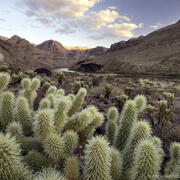San Francisco Bay-Delta
The Bay-Delta is a nexus for challenging issues about water, ecosystems, and human use. USGS science helps address key problems and uncertainties.
Grand Canyon Monitoring and Research Center
How does Glen Canyon Dam affect downstream Colorado River resources?
Lake Tahoe
An underwater view of periphyton growing on rocks near the shore of Lake Tahoe with a reflection of the rocks on the water surface
Salton Sea
The Salton Sea is facing many challenges as inflows and water levels decline. USGS science helps identify problems and evaluate possible solutions.
New Technologies for Mapping Surface Soil Moisture
Coastal Dwellers
Southwest Region
The Southwest Region covers Arizona, California, Nevada, and a portion of southern Oregon. Our scientists do a broad array of research and technical assistance throughout the U.S. and across the globe. The Regional Office, headquartered in Sacramento, provides Center oversight & support, facilitates internal & external collaborations, and works to further USGS strategic science direction.




